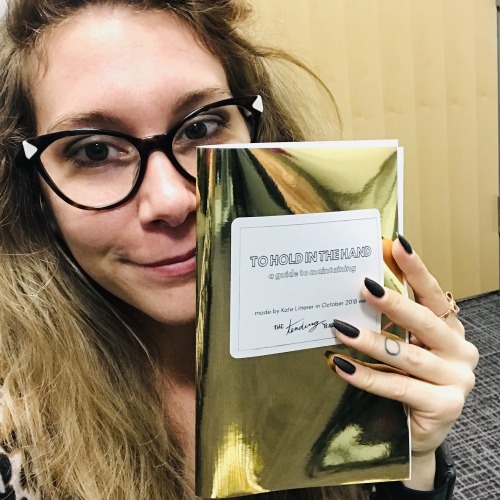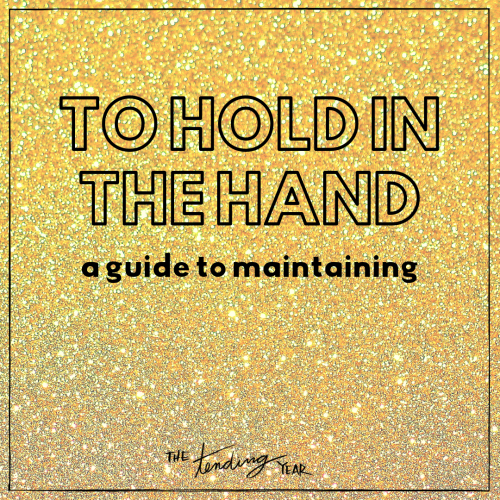The Latin root of the word “maintain” is manu tenere, which means to hold in the hand.
So cool, right? And very fitting for this month’s theme of practice. This week’s post focuses on the active experience of maintaining. I’m very excited to share it with you for two reasons:
- I made a print guide version! I’m giving away 15 free copies! More details on this at the end of this post
- I am really, very, tremendously proud of it.
The guide arose from the questions I asked myself, so I’ll open the blog this week with my reflection on how it felt to actively maintain new habits last week. Then, I’ll walk you through the guide’s questions, which you can answer in your mind, on paper, or in dialogue with a friend. I hope you find this practice as fulfilling as I did!
What I Held in the Hand
Although the guide mentions my renewed focus on my stretches and muscle retraining, I want to share here about a second maintenance practice I tackled last week: being more conscious about my social media and email usage.
I noticed that I had fallen back into the habit of checking Instagram, Facebook and my email A LOT more often than was necessary. The following is an inexhaustive list of when I had urges to check my social media and email: feeling stuck on a writing task, sitting at red lights, taking a bath, walking the dog, pausing in between sentences while I wrote my blog draft, and, perhaps most freaky, in the three to five seconds right after I closed out of social media/email and put my phone down. Social media and email are truly addictive.
Once I noticed what kinds of cues were triggering me to open up my phone or a new tab, I started to ask myself “Do I really want to do this right now?” Sometimes, the answer was “yes”: I had something to post, I wanted to send an email, or I chose to consciously relax by looking at pictures of chihuahuas in tiny, puffy jackets. More often than not, however, the answer was “no.” Going with “no” meant going screen free, and I spent more time noticing the changing leaves, reading magazines, tackling complex dissertation questions, or simply just sitting alone in silence (which became surprisingly refreshing). I even decided to spend the first few hours of my work-from-home days sans-laptop, not checking email or social media until around 10AM! I could feel my reliance on the blue screen seeping out of me, and it felt great.
What I appreciated most about intentionally maintaining my social media and email practice is that I started to replace a habit that didn’t serve me with a really wonderful habit of slowing down and being present.
In the guide that follows, you will have the option to identify what practices and habits you would like to actively maintain. If you have any questions while you’re working through the guide questions, shoot me an email at thetendingyear@gmail.com or post on my Instagram or Facebook. If I don’t respond right away, don’t worry: I’m just maintaining my practice.
I made this guide because I was struggling.
Namely, I couldn’t seem to keep up my physical practice of stretching and retraining my muscles as a way to manage chronic pain. Because my pain has improved over the last year and a half, I fell into what I call the “antibiotic” trap—I felt better, so I stopped stretching.
This guide documents my process of reconceptualizing and reincorporating maintenance into my life by connecting it to my long- and short-term goals for self development.
I was inspired to make a print zine version of my blog post by Cody Cook-Parrott’s zines and by the pieces produced by the artist’s union Impractical Labor in Service of the Speculative Arts. I wanted to make a guide that you could hold in your hands, read on the bus, write in, dog ear, read in the bath, photo copy, share with your friends, and adapt to your own uses. If you take only one thing away from this guide, I hope it is this:
Your purposes are worth maintaining.
Maintain is a Verb
The verb maintain is defined by the OED as follows:
- Cause or enable (a condition or situation) to continue;
- Provide with necessities for life or existence;
- State something strongly to be the case; assert.
The Latin root of the word is manu tenere, which means “to hold in the hand.”
When I hear the verb maintain, I usually think of the thing that is being maintained: a decision, a direction, a state of being, an opinion, etc. I view it as something that continually occurs/has already occurred. But spending the last week practicing maintaining taught me this:
MAINTENANCE IS AN ACTIVE EXPERIENCE THAT REQUESTS OUR PRESENCE AND CELEBRATES OUR PURPOSE.
Maintain Via Habit
Gretchen Rubin writes in the “A Note to the Reader” section of her book on habit formation, Better than Before, that “Habits are the invisible architecture of daily life. We repeat about 40% of our behavior almost daily, so if we change our habits, we change our lives” (xi). And habit researcher Charles Duhigg breaks down habit formation to this formula:
CUE → ROUTINE → REWARD
I spent a whole month of The Tending Year researching and practicing habit formation (weeks 15, 16, 17, and 18). The Cue → Routine → Reward thing really does work, but you have to work it to fit your own life, preferences, goals, etc.
Here’s an example: if my cue is my alarm, and my routine is to snooze many times, my reward is more time in my cozy bed. However, negative results are hurrying to get ready for work every morning and hoping I won’t snooze too long. I got fed up with worrying I’d be late to work, so I changed my habit as follows: same cue (alarm, but now set for 6:52am), new routine of snoozing only once (which did require “WAKE UP” post its on my phone at first), new reward: I wake up at 7am and take my time getting ready in the morning. I am now so motivated by the reward that I don’t snooze more than once.
The remainder of this guide asks questions to help you:
- personally connect to the act of maintaining
- identify what you’d like to maintain
- and why you’d like to maintain it
- narrow to just one goal
- and really identify the reason why that one
- decide what actions you will take
- root them in purpose
- and hold your actions in your present, celebratory hand
Write your answers to the following question in a notebook (or the printed guide):
1. What do I already maintain?
2. What would I like to maintain? List multiple things.
3. Why do I want to maintain those things?
If you answer “because I should,” ask “why” until you reach an answer that is rooted in personal growth vs. external pressure. Check out Bunny Michael’s Instagram for great examples of shifting perspective from a place of fear/scarcity/negative self talk to one of personal growth and acceptance.
4. Choose one thing from your list that you’d like to actively maintain.
5. Root that maintaining in PURPOSE. Fill in the blanks:
I choose to__________
because__________
Cue
6. When will I maintain? Time of day + session length + how often. Why then?
7. Where will I maintain? Same place every time, or varies? Why there?
8. Will I maintain alone? With others? Why?
Routine
9. What will I hold in my hand? Imagine the actions & process. List the steps you will take..
10. How did writing that list make you feel? Write, then take a breath. Scale down if necessary. Remember that your goal is to stay present in your practice.
Reward
Although your maintaining will likely provide long-term results, my hope is that you will also source reward through the action of maintaining. That may feel new to you. Many people (particularly those of us with complex traumas) have internalized a message that focusing on personal growth or healing is frivolous. And we may feel nervous to intentionally connect to being present.
I promise you that you deserve to hold your personal growth in your hand. You deserve to heal, write, learn, strengthen, create, notice, slow down, have fun, be vulnerable, set boundaries, feel like a boss, not always be the strong one, question, love, make mistakes, and thus…
you deserve to cherish the practice as much as the result.
11. Write a mantra to repeat while you maintain (it can be similar to the one from question 5)
And finally…practice maintaining!

Want a Print Version of the Guide?

I’m giving away 15 free copies of it!
Send me an email at thetendinyear@gmail.com or a private message on my Instagram account (thetendingyear) to introduce yourself or say hello and give me the address you’d like me to mail it to.
I’ll update my Instagram account when they’ve all been claimed.
I hope you enjoy working through the guide as much as I enjoyed using for my own maintaining purposes and as much as I enjoyed creating it!
*Please note that the original version of this blog post was published here.
Newsletter
Sign up below to access my free newsletter, Tending with Dr. Kate Henry.

